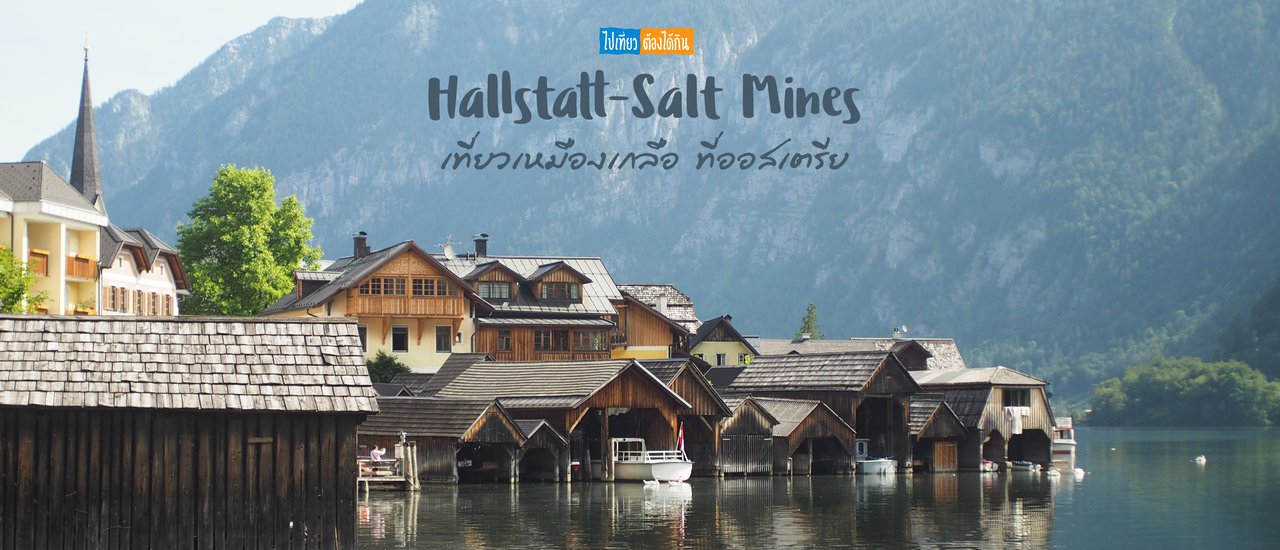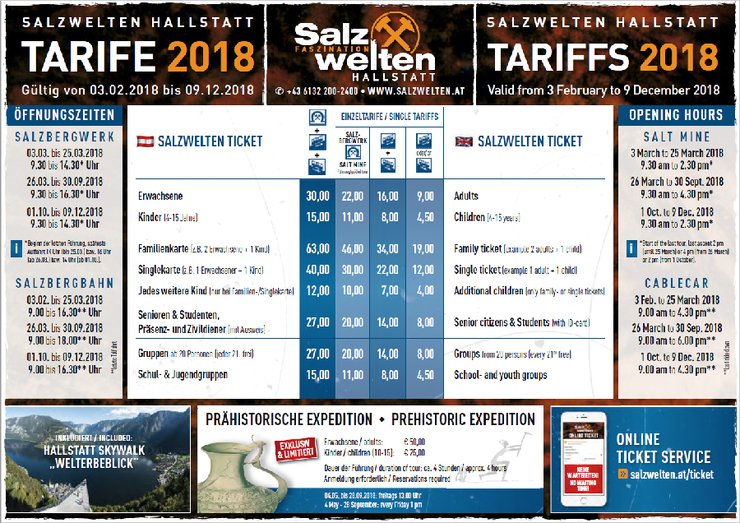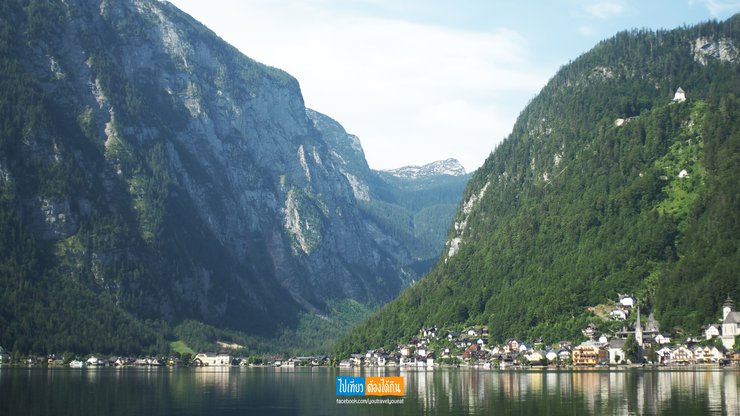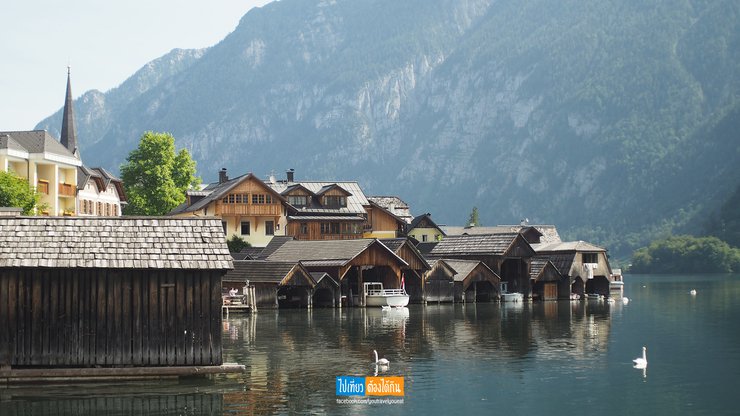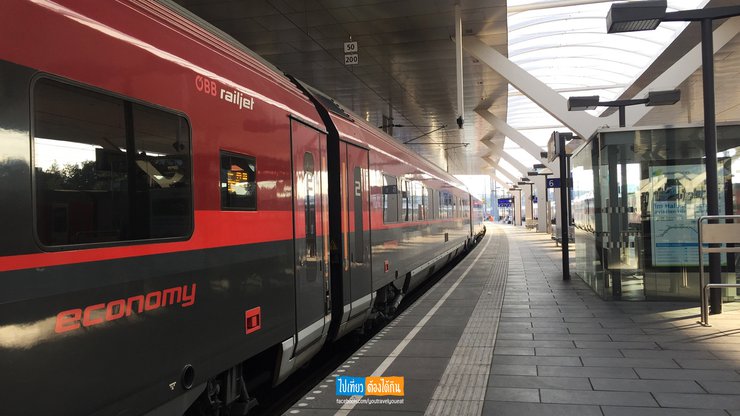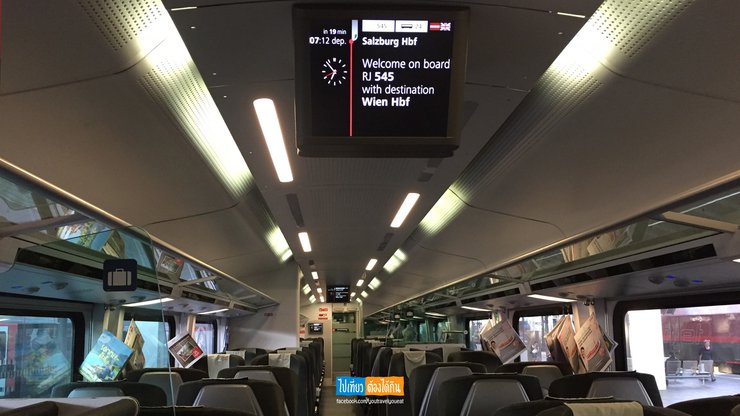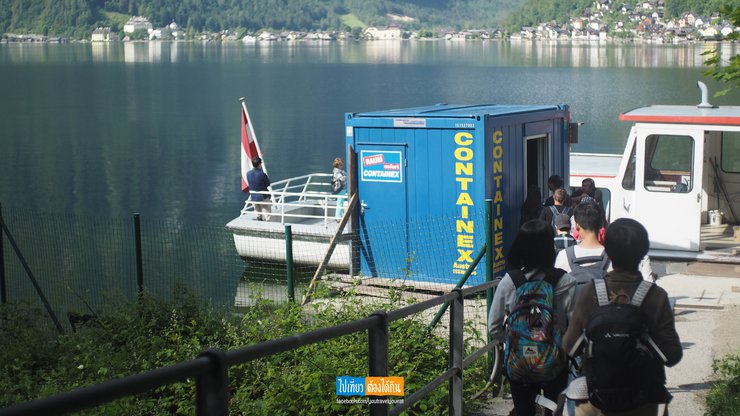Hello everyone, this is my third review on Readme.me. Please follow and support me. ^^
This time, let's change from traveling in Thailand to traveling in Europe. This review will share my experience and how to travel to the salt mine in Hallstatt, Austria as a 1-day trip.
Hallstatt - In addition to having a beautiful lake, there is also the oldest salt mine in the world. And this salt mine is what brought prosperity to this small village. And Hallstatt is listed as a World Heritage Site.
World Heritage site Cultural Landscape type
(Information by: UNESCO)

This review is divided into 3 parts:
- Travel and train ticket booking -
- Salt mine tour -
- Fishing village and restaurant -
Ready to go on a trip?

- Train Ticket Booking and Travel -
> Train Ticket Booking <
Hallstatt is located in the state of Upper Austria, Austria.
It is home to the Salzkammergut World Heritage village.
The primary modes of transportation are trains and buses. Journeys can begin from various locations, with the most popular starting points for tourists being Vienna and Salzburg.
This review will introduce train travel. First, let's get to know Austria's trains. The train that takes us to Hallstatt is operated by OBB. OBB trains have two types of tickets.
First type - Full price tickets can be purchased at the counter or booked online.
Type Two - Discounted Tickets (or OBB Sparschiene)
These tickets can be booked 2-3 months in advance and offer significant discounts. However, they are only available for online booking. It's important to note that these tickets are non-refundable and non-changeable, meaning you cannot modify your travel date after booking.
Website of OBB >> http://www.oebb.at/en/
We traveled round-trip to Hallstatt for 24 euros (9 euros each way, plus 3 euros for a seat). It was a sparschiene ticket, which we printed on A4 paper and used to board the train directly. There was no need to enter the code at the machine again.
The Railjet to Hallstatt
The Railjet train transported us to the picturesque town of Hallstatt.

...............................................................................................................................
> Travel <
Our journey began in Salzburg with the Obb train at 7:12 am, changing trains at Attnang-Puchheim Bahnhof for approximately 10 minutes, arriving at Hallstatt Bahnhof around 9:30 am.
After arriving at Hallstatt Bahnhof, I purchased a round-trip ferry ticket for €10 to cross to the Hallstatt Markt and Hallstatt Lahn areas, where the attractions, hotels, and restaurants for this trip are located.
The train from Salzburg station will terminate at Vienna. We will need to change trains at Attnang.

The train will drop us off at Hallstatt Bahnhof. Walk over to buy a round-trip boat ticket for 10 euros to cross to the Hallstatt Markt side.


Along the path to Hallstatt Lahn, both sides are lined with hotels, restaurants, and souvenir shops.


Visiting the Salt Mine
The salt mine is renowned for its archaeological discoveries, including human skeletons, tools, wooden stairs, and fabric fragments believed to belong to the Bronze Age. These artifacts were remarkably preserved by the salt within the mine. Today, the salt mine has been transformed into an educational site, offering visitors a glimpse into the history of salt production.
The salt mine is located on the Hallstatt Lahn side. We have to walk past the shops and take a small path to reach the Salzbergbahn Hallstatt ticket office, which also has a souvenir shop inside.
We purchased a Combined ticket for 30 euros, which includes round-trip tram rides and entrance to the salt mine. The tram entrance is located in the same zone as the ticket office. Alternatively, visitors can opt for trekking.
Salt Mine Train and Entrance Fees update 2018

The view from the tram, we will see the height of the tram

Upon arrival, you will be greeted by a map showing the location of each attraction. The highlights are the Heritage viewpoint and the salt mine tour.

Before going to the salt mine, we took a lift to see a small view at the highlight point.

Salzkammergut World Heritage Village

Walk back to the elevator and follow the small path that resembles a forest trail. You will encounter a museum housing Bronze Age human skeletons. Continue walking for approximately 15 minutes to reach the entrance of the salt mine tour.
Salt Mine Tour Entrance: This tour offers a 2-hour adventure.

The display showing tour times indicates that the 11:30 slot is the one we have booked. After passing the initial ticket check, we will need to deposit our belongings and large bags. Only small bags, cameras, mobile phones, and water bottles are allowed inside (storage is free). After depositing our belongings, we will change into mining worker attire. The staff will select our sizes for us. We will then join a large group that arrived earlier. Judging by their appearance, they seem to be a group of students aged 13-14, accompanied by three teachers. There are also five Koreans, two Chinese, two Japanese, two Thais, and four foreign uncles. In total, there are approximately 30 people in this tour group.
Change clothes before the mine tour

Upon arrival, the guide introduced themselves and informed the group that they were fluent in German, French, and English. After another round of ID checks, the mining crew was escorted to the tunnel entrance. Here, they were instructed to prepare their equipment, which consisted of water bottles and cameras instead of the usual picks and hammers. With that, the mine tour commenced.
A group of miners gathered around 11:30 AM, listening intently to a guide's explanation.

Stepping inside, it's dark and cool. This spot is still relaxing.

Walking steadily, it started to get dark and cold.

The guide explained the entrance to the first level, which is 85 meters deep. We couldn't hear the guide very well because we were at the back of the line, a group of Asian students.

The first room, the guide explained, contains translucent salt crystals that have been extracted.
Transparent salt crystals


As we continued walking, it started to get dark and the path became narrower. We came across the first mining slide, which was not very high, around 30-40 meters. Those who did not want to slide could walk down the stairs. However, we did not miss the opportunity to slide down. It was fun, and the children had a great time laughing. After we got down, the guide took us to watch a video about the origin of the salt mine.
Encountering the second slide, a must-visit spot with a thrilling 75-meter drop. Those who prefer not to slide can opt for the stairs. The children were ecstatic, while I, aware of the camera capturing the moment, couldn't help but grin as I descended. An exhilarating experience indeed.
Photos taken on the slide are available for purchase for 5 euros after exiting the mine.

The guide led us through a video mapping on the cave wall, showcasing the evolution of the salt mine. It's incredible how they managed to project such a display in such a confined space. The light and sound effects were spectacular, narrating the history of the mine in prehistoric times. Unfortunately, my camera couldn't capture the full effect, resulting in blurry and hazy images.
Mapping Light Up in Mines

From this point onwards, we will delve into the history of mining, exploring the work of miners from the Bronze Age to the present day. We will examine the extraction of salt, both wet and dry, and the discovery of the world's oldest wooden staircase.
Artifacts Found in the Mine

The world's oldest wooden staircase is believed to have been built by the Bronze Age people.

Exit the salt mine, take a long ride on the tram.

After completing a two-hour tour of the salt mine, I gained a wealth of knowledge and had a lot of fun. If you're planning a trip to Hallstatt, I highly recommend visiting the salt mine. The management and presentation are excellent.
A tour of a salt mine may not be suitable for those with claustrophobia or a fear of darkness, as the interior of the mine is authentic and can be quite confined and dimly lit.

- Fishing Village and Restaurants -
> Fishing Village <
After visiting the salt mine, we took a stroll along the lakeshore. This lake was once a fishing village, home to real fishermen, before it became a full-fledged tourist destination.
A small village nestled amidst the mountains and a lake.

The old wooden houses on the hillside, along with the boathouses by the lake, have been transformed from their original function as fishermen's dwellings. Today, they have become restaurants and hotels. This change is inevitable, as time passes and users change, so does their function. One reason for this transformation is to accommodate tourism, while another important reason is for preservation. Similarly, the wooden houses in Amphawa have been converted into homestays, and in Kyoto, the Ninenzaka and Sannenzaka (the path leading to Kiyomizu-dera Temple) have also seen their traditional houses converted into shops.
A former wooden house nestled on a hillside, now serving as a guesthouse.

Boathouse by the lake

Restaurant
The restaurants here mainly focus on the lake view. The menus are almost the same in every restaurant, offering typical Austrian dishes.
Grilled Sausage with Fries for €10


Ending the review with a picture of the resident cat. Thank you for reading this far ^^

You travel (Around the world)
Wednesday, February 26, 2025 6:20 PM

